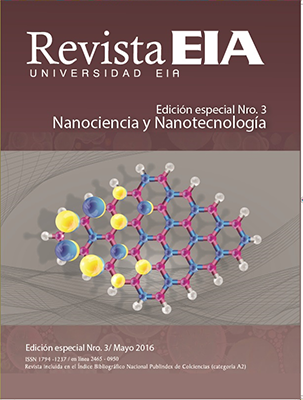PREPARATION OF CHITOSAN NANOPARTICLES MODIFIED WITH SODIUM ALGINATE WITH POTENTIAL FOR CONTROLLED DRUG RELEASE
PREPARATION OF CHITOSAN NANOPARTICLES MODIFIED WITH SODIUM ALGINATE WITH POTENTIAL FOR CONTROLLED DRUG RELEASE
Article Sidebar
How to Cite
Herrera Barros, A. P., Acevedo Morantes, M. T., Castro Hoyos, M. I., & Marrugo Ospino, L. J. (2016). PREPARATION OF CHITOSAN NANOPARTICLES MODIFIED WITH SODIUM ALGINATE WITH POTENTIAL FOR CONTROLLED DRUG RELEASE. Revista EIA / English Version, 12(2), 75–83. Retrieved from https://revista.eia.edu.co/index.php/Reveiaenglish/article/view/988
Published:
May 16, 2016
Section
Artículos
Licencia
![]()
Esta obra está bajo una Licencia Creative Commons Atribución-NoComercial-NoDerivativa 4.0 Internacional
Main Article Content
Adriana Patricia Herrera Barros
María Teresa Acevedo Morantes
Universidad de Cartagena
Manuel Ignacio Castro Hoyos
Leandro José Marrugo Ospino
Abstract
Chitosan nanoparticles modified with sodium alginate (CA) were synthesized using an ionic gelation method with pentasodium tripolyphosphate (STPP) as a crosslinking agent to evaluate their behavior as a drug carrier. Four samples were prepared (CA1-CA4) with different proportions of modifier agent alginate (0.5 and 1 mg / ml) and crosslinker STPP (1.5 and 2 mg / ml), maintaining a fixed concentration of chitosan (2.25 mg / ml). These nanoparticles were suspended in biological buffers to emulate the basicity and acidity conditions of the human gastrointestinal tract (pH 7.4 and 1.2 respectively). Hydrodynamic sizes of the synthesized nanoparticles were determined using dynamic light scattering (DLS). Based on these measurements, a hydrodynamic diameter of 152 nm was estimated for the best combination of chitosan-alginate-STPP. Tests were conducted to measure the encapsulation and controlled drug release capacity of the synthesized nanoparticles using rhodamine B as a tracer. From this evaluation, an encapsulation capacity of approximately 52% and values of dye release of 36% (pH 7.4) and 46% (pH 1.2) were observed, suggesting the potential of these nanoparticles for biomedical applications.
Article Details
Author Biographies
##ver##


 PDF
PDF
 FLIP
FLIP